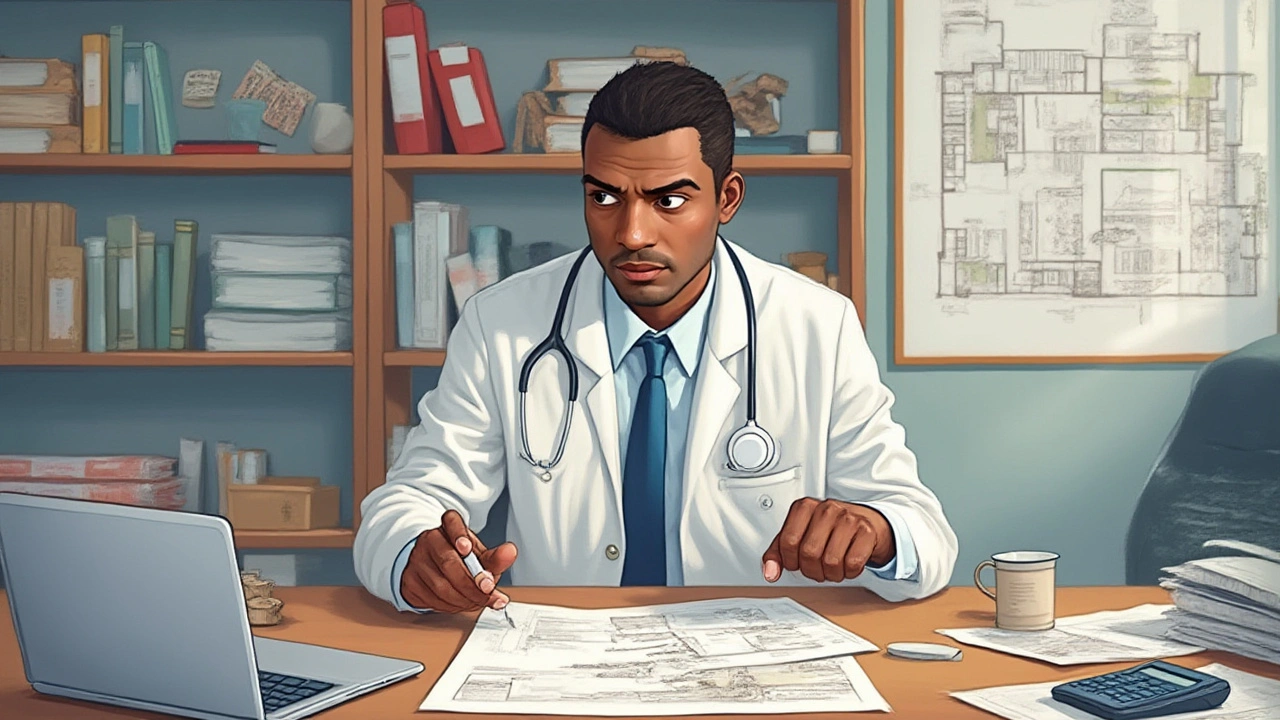Pharmacies are everywhere, but the reality behind opening one is way grittier (and more fascinating) than you might guess. Here’s a wild fact—over 15,000 independent pharmacies were operating in the U.S. by the end of 2024, chugging along even as big chains elbow their way through the market. Tons of people think pharmacies are gold mines because they see steady lines and prescription bags. But what you don’t see is the labyrinth of permits, upfront expenses, and unexpected red tape lurking behind those doors. If you’re dreaming of handing over the first prescription under your own roof, there’s a lot that can trip you up. But hey, I’m here to break down what actually works—and what doesn’t—if you want to join the proud (sometimes sleep-deprived) crew of pharmacy owners today.
Understanding the Pharmacy Business Landscape
The pharmacy business is nothing like your average corner store. It’s a hybrid beast: part healthcare, part retail, and one hundred percent regulation magnet. Giant players, like CVS and Walgreens, may seem to saturate the market, but according to the National Community Pharmacists Association, independents still fill nearly 36% of retail prescriptions. That’s huge. Rule number one: don’t let chain dominance make you doubt your shot—patients crave personal service and advice from real people. The bad news? You’ll be competing for reimbursements and customers with insurance negotiations, mail-order giants, and sometimes even the very doctors writing those scripts.
The landscape keeps changing. There’s the jump in telehealth, and more folks love medication delivery apps. But here’s your real ammo: community relationships. In a 2024 study, 71% of Americans said they’d rather use a local pharmacy if it’s convenient. So, nailing down a good neighborhood with real foot traffic can set you up against the algorithms and national ads. Don’t ignore digital: setting up prescription management apps, simple websites, and text reminders win trust. More states now also let pharmacists prescribe certain medications and vaccines—an edge that makes your pharmacy a health hub, not just a pill dispenser.
Financially, it’s a rollercoaster. The average independent pharmacy earned about $4.2 million in annual sales last year (NCPA Digest, 2024). But margins are razor-thin—gross profit as a percent of revenue is often only 22-24%. The rest disappears into insurance clawbacks, inventory, and payroll. That’s why careful location scouting, a sharp eye on costs, and constant reinvention are musts for survival. Graveyard stories are common: stores open and close fast when owners misjudge the neighborhood, stock the wrong inventory, or ignore little daily losses.
Pharmacies are also community fixtures. People count on them for accurate advice, emergency meds, and trust. You’re on the front line during flu season, blizzards, or even public health crises. So, the first step is not writing a business plan. It’s being sure you love the idea of serving people long after the 9-to-5 grind, because everything else—negotiating leases, wrangling state boards, and chasing insurance payments—will make you want to toss your white coat if you’re not all in.
Legal Requirements, Licenses, and Permits
If you only remember one thing, it’s this: pharmacies are some of the most regulated businesses out there. You’ll need to juggle state, federal, and often local rules before even buying a single pill bottle. The process is slow, so plan for months, not weeks, before you open your doors.
First, let’s talk basics. Every state has its own board of pharmacy, and that’s where you’ll apply for a pharmacy license. The application pile includes your store layout, proof of pharmacist-in-charge, financial disclosures, and criminal background checks. If you’re planning to dispense controlled substances (you will), get ready to register with the DEA. The federal Controlled Substances Act means there’s a paper trail for every milligram that crosses your counter. And don’t skip your state’s Medicaid program—many patients rely on it, and it’s another layer of registration and audit potential.
Beyond the pharmacy itself, your business needs a general business license, tax ID number, and sometimes city or county permits. Expect a fire marshal inspection, health department sign-off (especially if you offer immunizations), and Americans with Disabilities Act compliance—every ramp, shelf, and bathroom counts. Want to bill insurance? Plan for credentialing with pharmacy benefit managers (PBMs) and multiple insurers, a process that can take up to six months.
Some states require compounding licenses if you plan to mix custom medications. Others demand extra certifications for selling durable medical equipment, like oxygen or walkers. Want to deliver prescriptions? Some local governments need a separate permit for that, too.
Bear in mind, every key staff person—especially pharmacists—must be individually licensed. Pharmacy technicians usually need state registration and background checks. And here’s a tip most guides skip: Don’t try to outsmart the system. Pharmacies face regular, unannounced inspections. Mess up even a little—a mislabeled bottle, untidy storage, or a missed logbook—and your doors could be shut before you even celebrate your grand opening.

Start-Up Costs and Funding Your Pharmacy
Let’s talk money—because opening a pharmacy isn’t cheap. The lowest startup costs, even in smaller towns, are around $300,000. Big city shops can easily cost $1 million+. Here’s where the cash goes: real estate and renovations (that means making it look spotless, safe, and compliant), pharmacy technology systems, shelving, drug inventory, insurance policies, and payroll for at least a few months before profits roll in. Most new owners underestimate how much inventory alone drains the bank. You’ll need to pay cash upfront to drug wholesalers before you earn a dime back.
| Startup Expense | Estimated Cost (USD) |
|---|---|
| Lease/Renovation | $75,000 - $250,000 |
| Pharmacy Systems (POS, EHR, Security) | $40,000 - $70,000 |
| Drug Inventory | $70,000 - $150,000 |
| Licenses and Permits | $1,500 - $10,000 |
| Attorney/Compliance Fees | $5,000 - $25,000 |
| Insurance (Malpractice, Business, Theft) | $10,000 - $30,000 |
| Operating Cash Reserve | $50,000 - $120,000 |
Bank loans and SBA (Small Business Administration) loans are the most common ways to fund all this. Lenders want to see a rock-solid business plan, clear location analysis, and real experience in the field (or at least a sharp business partner who does). Don’t forget to factor in slow reimbursement times; it can take a month or more to actually get paid by insurance for prescriptions you already filled.
Some wholesalers offer start-up programs: you buy drugs from them, and they give you payment flexibility plus some technology or marketing help. Working with independent pharmacy buying groups can also unlock discounts. And don’t ignore grants for health initiatives; underserved areas and rural locations sometimes score public funding or tax incentives to attract new healthcare businesses.
If you’re not ready to risk six figures, franchising may be an option. Several national brands let you open under their umbrella (with support, bulk purchasing, and marketing muscle) for a fee. But you’ll trade independence for structure—so weigh the trade-off. Real talk: don’t bet your life savings without a clear map for how you’ll break even, which usually takes 12-24 months, even for the most careful owners.
Staffing, Inventory, and Setting up Operations
A pharmacy thrives (or dives) on its people and its systems. Top of the list: a licensed, reputation-strong pharmacist-in-charge. This person (it might be you) is the leader, mentor, and last stop for every medication and counseling decision. But you’ll likely need pharmacy technicians (who prep prescriptions, ring up sales, and tackle paperwork) and at least one administrative staffer for billing, accounts, and insurance wrangling.
Want to build unbeatable loyalty? Hire people who know the community—maybe locals or people who speak your patients’ languages. Pay and benefits matter too: the average pharmacist salary is around $135,000/year, and good techs earn about $40,000. Cutting corners here almost guarantees high turnover (and cranky patients).
Now, inventory is a beast. Plan for your stockroom to swallow up more cash than you expect. Most pharmacies keep $70,000 to $150,000 in meds on the shelves, from common generics to pricey specialty drugs. Get cozy with your major drug wholesalers—AmerisourceBergen, McKesson, and Cardinal Health are the big three. Ordering software now tracks expiry dates, auto-reorders hot sellers, and flags weird patterns to avoid fraud or waste. Some systems even tie inventory to your point-of-sale and e-prescribing setup for ultimate efficiency.
Don’t just stock what you like. Analyze what’s popular in your neighborhood. Are nearby clinics treating lots of kids? Think antibiotics and asthma meds. Is your area heavy with seniors? You’ll move blood pressure, diabetes, and heart medications. If you don’t have what people need, they’ll head elsewhere in a heartbeat. Stock non-drug items—cough drops, bandages, reading glasses, even snacks. These have better profit margins than prescriptions and make your spot a one-stop shop.
Setting up operations means making your workflow ironclad. Prescription processing software cuts mistakes, but only if your staff checks for drug interactions and insurance rejections every time. You’ll need physical security, like locked narcotics safes, alarm systems, and constant camera coverage. Most states require logbooks to track every step: receiving, dispensing, destruction, and returns of prescription drugs.
- Build relationships with local doctors and clinics.
- Offer delivery or curbside pickup—patients expect it since 2020.
- Set clear hours, but offer at least some early mornings or evenings for working families.
- Emphasize privacy and respect—setup private counseling areas for sensitive discussions.
- Train staff in customer service, not just compliance. Word-of-mouth keeps you in business.

Promoting, Growing, and Sustaining Your Pharmacy Business
You’re open. The shelves are stocked. Now—how do you get customers through the door? Marketing makes a small pharmacy stand out against the Goliaths. Start with the classics: getting listed on Google Maps and pharmacy finder sites, reaching out to local doctors, and hosting vaccination clinics or health fairs. Then, think digital. Launch a simple website with refill request forms, hours, and services. Set up basic online ads that target folks near you.
Email and text reminders keep regulars loyal. Announce flu shot season, new products, or extended hours. Use social media to share health tips, staff bios, and community stories. Got a multilingual community? Make sure your materials and signs are in the right languages.
Here’s where a little extra effort pays off. Offer extras: free blood pressure checks, medication reviews, diabetes education, and vaccine clinics. Partner with senior centers, sports teams, and local businesses for benefits days or health screenings. If you handle specialty drugs, build direct physician referral networks. Every handshake and small favor turns into steady business. One legendary Brooklyn pharmacy even hosts monthly "Ask the Pharmacist" nights, drawing in neighbors who never thought twice about who fills their scripts.
Patient experience is your ace. Be helpful, never rushed. Stand out for speed and accuracy, but also for remembering faces and names. It’s easy: a 2025 retail study showed 67% of Americans would switch pharmacies for better service, not just price.
Protect your margins by reviewing reimbursement contracts every few months. Join pharmacy associations; they offer legal help, benchmarking data, and the latest info on industry shifts. Keep squeezing costs by joining buying groups and renegotiating with vendors every year.
Think long-term. The pharmacy business is always evolving. More states are letting pharmacists test for strep or flu. Remote consultations and specialty meds keep getting bigger. Stay on top of tech upgrades, regulations, and new services. Don’t be afraid to pivot—successful pharmacy owners are the ones who adapt, not the ones who just fill scripts.



Ashton Strong
July 17, 2025 AT 23:11Launching your own pharmacy is indeed a commendable venture, and this step-by-step guide offers an essential roadmap for aspiring pharmacy owners. One aspect that I particularly appreciate is the focus on real costs and regulatory requirements, which can often be overlooked but are critical to success.
From my experience, it is crucial to meticulously plan your budget and seek expert consultation, especially when navigating complex pharmacy regulations. Understanding the nuances of insurance reimbursements, inventory management, and staffing will significantly impact the sustainability of your business.
The hurdles mentioned can appear daunting, but with a well-structured approach and continuous learning, they can be systematically mitigated. I encourage new entrepreneurs to engage with local pharmacy associations to glean practical insights and build a reliable professional network.
Overall, this guide should serve as a valuable foundation. If anyone has specific questions about initial licensing or insurance, I am happy to share more detailed advice.
Steven Hanton
July 22, 2025 AT 08:45This is a thorough guide that nicely highlights the critical steps involved in starting a pharmacy. However, I’d love to gain further clarity on certain points, such as the process of meeting compliance standards and how to effectively navigate them.
What are some practical strategies for ensuring that a new pharmacy remains compliant with regulations over time, especially in a changing legislative environment? Also, are there recommended technology solutions to streamline pharmacy operations?
I believe having a solid framework for compliance and workflow optimization will be key to success, especially for first-time pharmacy owners who might find the regulatory landscape complex and intimidating.
Pamela Tanner
July 25, 2025 AT 17:18This guide is a well-constructed resource for those considering opening a pharmacy. I found the inclusion of common hurdles particularly helpful, as they prepare the reader for challenges ahead, rather than presenting an overly optimistic picture.
One aspect I would emphasize is the importance of community engagement. Building trust with local customers not only drives business but also positions the pharmacy as a critical healthcare resource.
Moreover, ensuring clear and accurate signage, maintaining a knowledgeable staff, and offering personalized service will enhance customer loyalty. Consider how digital presence and local advertising could also contribute significantly to early success.
Kristina Kalolo
July 28, 2025 AT 20:51The article provides a nice overview, but I am curious about how one might manage financial risk during the initial stages. Is there advice on obtaining loans or investors specifically tailored for pharmacy startups?
Also, are there any successful case studies or examples from various regions that demonstrate different approaches to overcoming initial regulatory or market challenges? This would be extremely useful to understand potential variations in the process.
ravi kumar
August 1, 2025 AT 00:25Opening a pharmacy is no small feat and requires a detailed plan, especially when it comes to compliance and financial management. In the Indian context, many businesses face delays in licensing, which can significantly impact timelines.
Therefore, it is wise to consult with local regulatory bodies early in the process and engage with experienced consultants. Also, building relationships with reliable suppliers is crucial to ensure uninterrupted inventory.
Lastly, paying attention to the location and accessibility of the pharmacy can make a substantial difference in attracting regular customers.
Megan Blakeman
August 3, 2025 AT 09:38Wow, this guide really touches on every critical aspect! One cannot forget the emotional side of starting a business, especially a pharmacy which serves the community so closely. The patience and resilience needed cannot be overstated!!!
Besides the financial and regulatory steps, I think what truly sets a pharmacy apart is how well owners nurture their team to be empathic and responsive to customers’ needs.
Also, embracing technology like electronic health records and mobile apps can enhance service significantly. It's super important to keep evolving!!!
Thanks so much for sharing this detailed guide 😊😊😊!!!
Akhil Bellam
August 4, 2025 AT 13:25Honestly, this guide seems a tad too simplistic for the truly discerning entrepreneur. Anyone with even a modicum of experience knows that real challenges lurk beneath these 'common hurdles,' especially in sourcing high-quality pharmaceuticals and dealing with unethical competitors that may undercut prices disastrously.
The average reader might not grasp that successfully launching a pharmacy is as much about mastering complex supply chain intricacies and industry politics as it is about understanding regulations.
Furthermore, the role of marketing is grossly underplayed. Simply knowing how to open the doors won't ensure the traffic will pour in, let alone convert into loyal customers.
Anyone intending to embark on this journey must prepare for a fierce battle of wits and resources, not to mention the stress that inevitably comes along.
Amber Swartz
August 8, 2025 AT 00:45Okay, but can we talk about how many entrepreneurs totally underestimate how personally draining opening a business can be? Like, I get the steps, the costs, the hurdles, but nobody really prepares you for the sleepless nights and stress-fests.
Also, let’s not sugarcoat the bureaucracy—it can be a total nightmare! I wonder if there's a way to speed up the licensing process through some kind of advocacy or insider tips?
Plus, beyond the operational stuff, the emotional rollercoaster is REAL. A support system is a must-have.
Would love to hear if anyone has some solid advice on managing stress while keeping the business growing!
Robert Byrne
August 10, 2025 AT 08:18While this guide is generally useful, it seems a bit too cautious in laying out the realities. Frankly, the pharmaceutical business can be cutthroat with minimal room for error, especially in smaller markets.
Many folks jump in without the proper groundwork and end up closing shop when confronted with the intense competition and regulatory scrutiny. There's a need to be brutally honest about the risks involved, or else people waste time and capital.
Still, for those serious about this path, thorough research, robust mentorship, and constant adaptability are non-negotiable. Don't just rely on generic guides.
Tia Muzdalifah
August 16, 2025 AT 23:11hey everyone, just wanna say this guide is pretty chill for a newbie like me. i’ve been thinking about this for a while and it’s good to see someone break it down clearly without making it scary.
Though, i’m curious about the tech side? like, do pharmacies need to have some kinda app or website now to keep up? or is it still mostly walk-in stuff?
also lol, dealing with insurance sounds like a whole other beast. anyone got tips on making that side less of a headache?
appreciate all the advice here so far :)